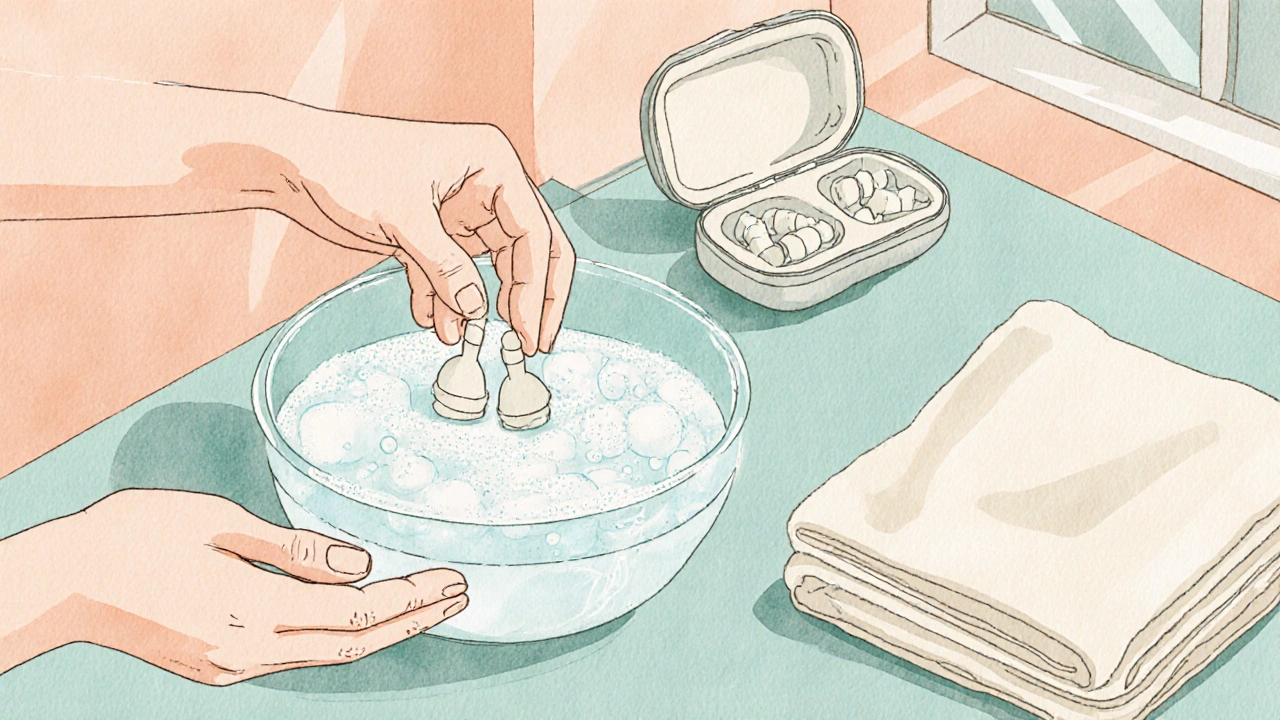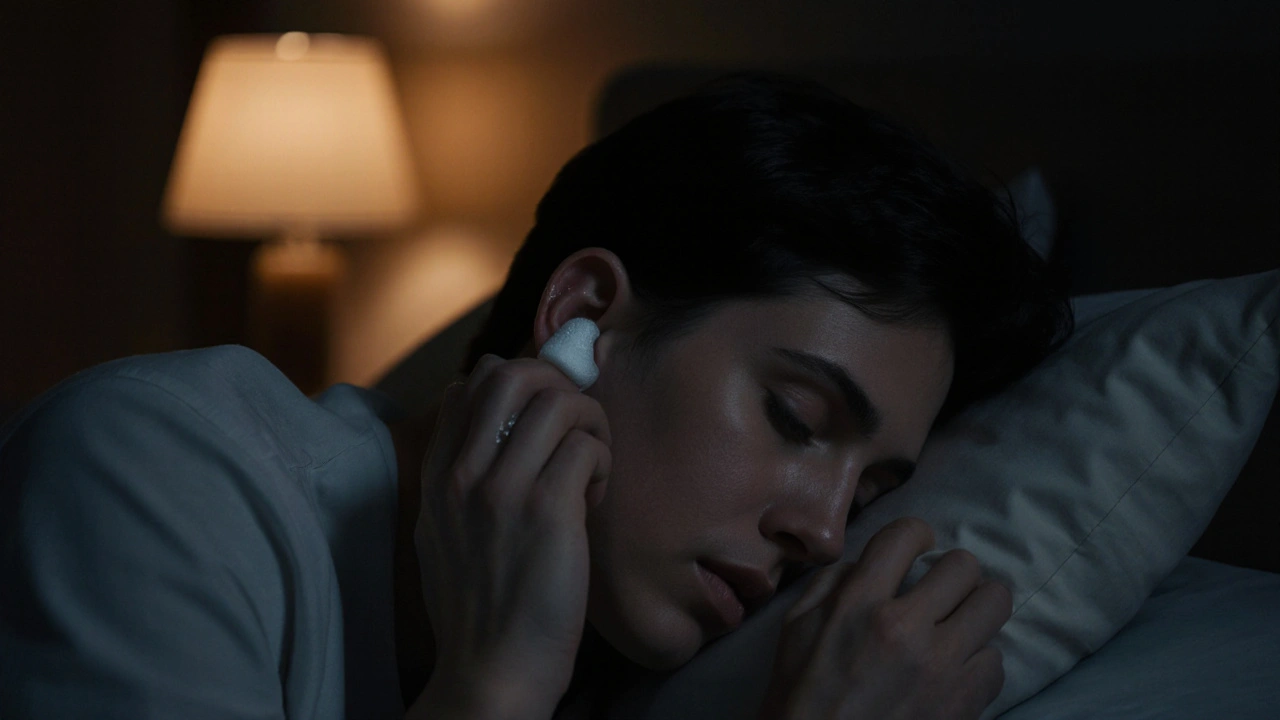Earplug Infection Risk Calculator
This tool helps you understand your personal risk of developing an ear canal infection based on your earplug usage habits. According to the American Academy of Otolaryngology, 25% of ear canal infections in adults involve recent earplug use.
Personalized Recommendations
Key Risk Factors Found:
When you slip a pair of earplugs into your ears to block out noise, you expect quiet-not a painful infection. Yet many people wonder if those tiny protectors can actually invite bacteria or fungi into the ear canal. Below we break down the science, highlight the real risks, and give you a straightforward plan to keep your ears clean and safe.
Earplugs are small devices, typically made of foam, silicone, or wax, designed to reduce sound entering the ear canal. While they’re a go‑to solution for concerts, travel, or sleeping, improper use can create a moist, warm environment that microbes love.
How Earplugs Can Lead to Infections
Ear infections don’t magically appear; they need a pathway, a source of microbes, and conditions that let those microbes multiply. Earplugs can influence each factor:
- Occlusion effect: By sealing the canal, earplugs trap humidity from sweat and earwax, raising the temperature and moisture level-prime breeding grounds for bacteria and fungi.
- Physical irritation: Repeated insertion and removal can micro‑abrasion the delicate skin lining the canal, making it easier for microbes to breach.
- Contamination: If you reuse earplugs without cleaning, you may be re‑introducing organisms from previous wear.
These factors don’t guarantee an infection, but they increase the odds, especially if you fall into any of the following scenarios:
- Using earplugs for long stretches (more than 8‑10 hours at a time).
- Sharing earplugs with friends or family.
- Wearing earplugs while swimming, showering, or in high‑humidity environments.
Common Microbes Behind Ear Canal Infections
The medical term for an infection of the outer ear canal is otitis externa. Most cases are caused by:
- Bacteria-especially Pseudomonas aeruginosa and Staphylococcus aureus. They thrive in moist, warm spaces.
- Fungi-the most common being Aspergillus species. Fungal otitis is more frequent in hot, humid climates.
- Mixed infections-occasionally both bacteria and fungi are present, complicating treatment.
Studies from the American Academy of Otolaryngology (2023) show that 70% of ear‑canal infections in adults are linked to water‑exposed activities, and 25% involve recent earplug use.
Disposable vs Reusable Earplugs: Pros & Cons
Choosing the right type can reduce infection risk. Below is a side‑by‑side look at the two main categories.
| Feature | Disposable Earplugs | Reusable Earplugs |
|---|---|---|
| Material | Soft foam or silicone | Silicone, wax, or custom‑molded acrylic |
| Cost per use | Low (≈ $0.10 each) | Higher upfront (≈ $5‑$15) but reusable many times |
| Hygiene risk | Low if used once and discarded | Higher if not cleaned regularly |
| Lifespan | Single use | Typically 100‑200 insertions with proper care |
| Cleaning needed | None (just discard) | Wash with mild soap or specialized cleaning solution after each use |
For people who wear earplugs daily-like commuters, musicians, or shift workers-reusable models are cost‑effective but demand disciplined cleaning. If you only need earplugs occasionally, disposable ones eliminate the cleaning step and thus cut the infection pathway.
Best Practices to Keep Your Ears Healthy
Whether you pick disposable or reusable, follow these simple habits:
- Wash your hands. Before touching earplugs, clean your hands with soap. This blocks hand‑borne bacteria.
- Pick the right size. Earplugs that are too tight compress the canal, increasing irritation. Most brands offer small, medium, and large sizes-experiment until insertion feels snug but not painful.
- Dry them thoroughly. After exposure to sweat or water, let earplugs air‑dry for at least 10 minutes before reinserting.
- Clean reusable plugs after each use. Use warm water and a mild, fragrance‑free soap. Rinse well, then pat dry with a lint‑free cloth. For stubborn earwax buildup, a specialized earplug cleaning solution (often a dilute hydrogen peroxide mix) works well.
- Store in a clean container. A breathable, airtight case prevents dust and microbes from settling.
- Replace regularly. Even disposable plugs can degrade; swap them out after a few uses if they feel compressed. Reusable plugs should be retired after the manufacturer’s suggested lifespan or if you notice discoloration or lingering smell.
As a rule of thumb, if you ever feel itching, a dull ache, or notice discharge after using earplugs, give your ears a break and follow the cleaning routine.

When to See a Doctor
Most mild irritations resolve with proper hygiene, but certain signs signal a deeper problem:
- Persistent pain lasting more than 48 hours.
- Redness that spreads beyond the ear canal entrance.
- Fluid drainage that’s clear, yellow, or foul‑smelling.
- Hearing loss or a feeling of fullness that doesn’t improve.
- Fever over 100.4°F (38°C) accompanying ear symptoms.
An ENT specialist can diagnose otitis externa, prescribe antibiotic or antifungal drops, and advise if you need to stop using earplugs temporarily.
Quick Checklist for Safe Earplug Use
- Wash hands before handling earplugs.
- Choose the correct size for a comfortable fit.
- Keep earplugs dry; let them air‑dry after exposure to moisture.
- Clean reusable plugs with mild soap after each use.
- Store in a clean, breathable case.
- Replace disposable plugs after each use; retire reusable plugs after 100‑200 insertions or if they show wear.
- Watch for pain, itching, discharge, or hearing changes-seek medical help if they appear.
Frequently Asked Questions
Can wearing earplugs cause a bacterial infection?
Yes, if earplugs trap moisture and are not cleaned or replaced regularly, bacteria such as Pseudomonas can multiply and lead to otitis externa.
Are foam earplugs safer than silicone ones?
Both materials can be safe when used correctly. Foam plugs are usually disposable, lowering infection risk, while silicone plugs are reusable and need diligent cleaning.
How often should I clean reusable earplugs?
Ideally after every use. A quick rinse with warm, soapy water followed by thorough drying is enough for most situations.
What symptoms indicate I need medical attention?
Severe pain, persistent itching, drainage, hearing loss, swelling beyond the ear canal, or fever are red flags that warrant a doctor’s visit.
Can I share earplugs with a partner?
Sharing is not recommended. Even if they look clean, you’re transferring each other’s earwax and microbes, increasing infection risk.







Mark Haycox
October 13, 2025 AT 16:43These earplug warnings are just liberal scaremongering, stop the hystria.
Michael Taylor
October 13, 2025 AT 17:50Using earplugs can be a lifesaver for those who need peace, but it's essential to understand the hidden hazards.
First, moisture becomes trapped, creating a perfect breeding ground for bacteria and fungi.
Second, the constant pressure can micro‑abrasion the delicate skin inside the canal.
Third, reusing disposable plugs or neglecting thorough cleaning of reusable ones amplifies the risk.
Studies from the American Academy of Otolaryngology show that a quarter of otitis externa cases involve recent earplug use.
This statistic alone should motivate anyone who values their hearing to adopt better hygiene practices.
A simple routine-hand washing before handling, drying plugs for at least ten minutes, and replacing disposables after each use-can dramatically reduce infection rates.
For reusable silicone or wax plugs, a quick wash with mild soap after each wear is non‑negotiable.
Storing them in a clean, breathable case prevents dust and microbes from settling.
If you enjoy swimming or live in a humid climate, consider foam plugs that are single‑use, or at least ensure thorough drying.
Pay attention to warning signs such as itching, dull ache, or any discharge, because early intervention prevents complications.
Should symptoms persist beyond forty‑eight hours, consulting an ENT specialist is the prudent step.
Remember, protecting your ears from noise does not have to come at the cost of infection.
By combining vigilance with proper care, you can keep the music flowing and your canals clear.
Stay informed, stay clean, and let the silence be a blessing, not a threat.
Your ears will thank you, and you’ll avoid the dreaded ear canal infection.
Troy Brandt
October 13, 2025 AT 18:56When I first started using earplugs for night shifts I didn’t think about hygiene, but after a few weeks I noticed a mild itch that lingered.
I looked up the science and learned that trapped moisture is a breeding ground for both bacteria like Pseudomonas and fungi such as Aspergillus.
That knowledge motivated me to adopt a strict cleaning schedule: rinse the reusable silicone plugs with warm, soapy water after every use, then let them air‑dry on a clean towel.
I also keep a small waterproof case for storage, which prevents dust from settling while the plugs are idle.
For disposable foam plugs I now carry a fresh pair in my pocket and discard them after each insertion, eliminating the need for cleaning altogether.
If you ever feel a persistent tickle, a slight ache, or notice any discharge, give your ears a break and follow the cleaning routine before the problem escalates.
In short, consistent hygiene is the key to enjoying the quiet without the risk of otitis externa.
Angelo Truglio
October 13, 2025 AT 20:03Oh, the sheer audacity of those careless plug‑users, flaunting their ignorance as if personal comfort trumps public health!
They parade around with unwashed silicone, inviting bacterial hordes, while claiming “I’m just protecting my ears.”
Wake up! The science is crystal clear-moisture, irritation, contamination-an infection waiting to happen.
If you value your hearing, you will bow to the rigorous standards of hygiene, or else suffer the consequences.
Dawn Midnight
October 13, 2025 AT 21:10While I appreciate the passion, please note that “hordes” is not a precise term; the microbiological literature cites specific genera such as Pseudomonas and Staphylococcus. Additionally, “bow to the rigorous standards” is metaphorical and could be misinterpreted. A clearer phrasing would improve readability.
frank hofman
October 13, 2025 AT 22:16lol u guys sound like a bunch of old‑school nits, i just clean my plugs with a dab of dish soap n toss ‘em in the sun 🌞😂
Michael AM
October 13, 2025 AT 23:23Sounds like you’ve got a good routine-keep it up!
Erica Ardali
October 14, 2025 AT 00:30In the grand tapestry of auditory preservation, one must contemplate the existential weight of a simple plug; does it not echo the very fragility of our mortal hearing, demanding reverence and meticulous care?
Justyne Walsh
October 14, 2025 AT 01:36Oh, brilliant insight, as if we’re all philosophers pondering the meaning of foam. Grab a plug, wash it, and stop pretending it’s a metaphysical crisis.
Callum Smyth
October 14, 2025 AT 02:43Great points, everyone! 👏 Just remember a quick rinse and proper drying works wonders. Keep those ears happy! 😊
Bernard Lingcod
October 14, 2025 AT 03:50I’ve been asking myself why many people neglect cleaning-maybe it’s the inconvenience, maybe it’s the lack of awareness.
Either way, a simple reminder can shift behavior dramatically, especially when we stress the short‑term discomfort versus long‑term hearing health.
Raghav Suri
October 14, 2025 AT 04:56Exactly! If you’re serious about protecting your ears, get a dedicated cleaning kit and stick to it. Skipping this step is just begging for trouble.
Kelly Hale
October 14, 2025 AT 06:03Let me tell you why the American spirit demands the highest standards of earplug hygiene-because we value our freedom to enjoy music without the tyranny of infection.
We must stand tall, wash those plugs with vigor, and never surrender to the complacent whispers of “it’s just a tiny thing.”
Our ancestors fought for liberty; we fight for clean ears.
Uju Okonkwo
October 14, 2025 AT 07:10Friends, remember that we’re all in this together-sharing knowledge, supporting each other’s health journeys, and celebrating small victories like a clean set of plugs. Keep encouraging one another, and let’s make ear health a community priority.
allen doroteo
October 14, 2025 AT 08:16Sure, but the real issue is people think they’re immune. They’re not. Clean or die.
Corey Jost
October 14, 2025 AT 09:23While it’s easy to dismiss the hygiene debate as mere pedantry, the data unmistakably shows a correlation between poor plug maintenance and otitis externa incidents, especially in high‑risk environments like concerts or aquatic activities; therefore, adopting a regimented cleaning schedule isn’t just advisable-it’s imperative for anyone who values auditory health and wishes to avoid needless medical interventions that could otherwise be prevented with simple, consistent practices.
Nick Ward
October 14, 2025 AT 10:30All great advice here-let’s keep the conversation friendly and helpful! 😊